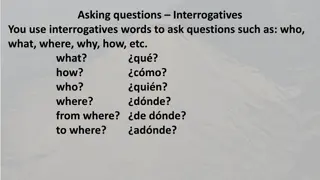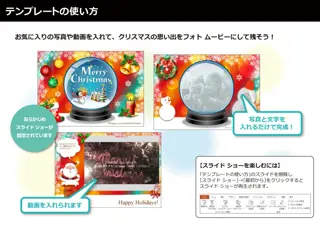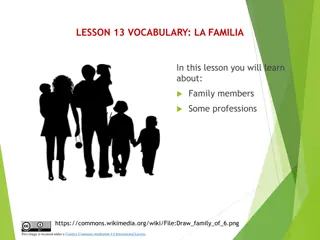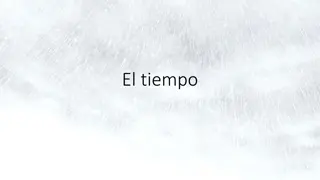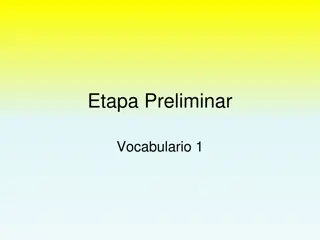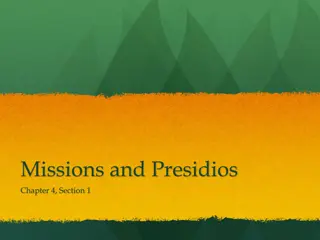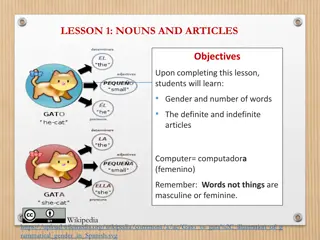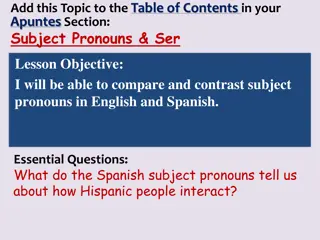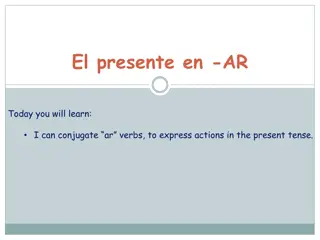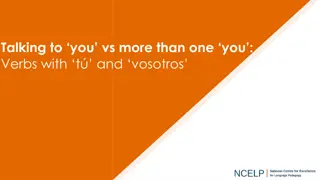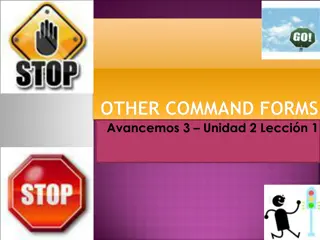Spanish Greetings: Tú vs Usted Explained
Understand the difference between informal and formal greetings in Spanish with Tú and Usted. Learn when to use each form depending on the situation, and explore common phrases for both types of greetings.
Download Presentation

Please find below an Image/Link to download the presentation.
The content on the website is provided AS IS for your information and personal use only. It may not be sold, licensed, or shared on other websites without obtaining consent from the author. Download presentation by click this link. If you encounter any issues during the download, it is possible that the publisher has removed the file from their server.
E N D
Presentation Transcript
ESPAOL 1 LECCIN PRELIMINAR Formal & informal Greetings
T VS. USTED In Spanish, there are multiple ways to say you . You have to use the correct you depending on what you want to express. Let s take a look at the friendly and formal you . T this you is the friendly/informal/familiar you. Usted this is the you you must use to people you don t know well, or to whom you want to show respect. Because we have 2 different versions here, we have to know the rules for when we ask How are you?
CMO ESTS? VS. CMO EST USTED? C mo est s? and c mo est usted? both mean basically the same thing. They both mean How are you? However there are two forms of saying this phrase in Spanish. There is the 1. friendly/familiar way and the 2. formal way. Let s take a look at each of them:
CMO ESTS? C mo est s? Is the friendly/familiar way to say How are you? It is generally answered with something like bien/mal/regular etc. And then the second speaker would respond by asking the first speaker how they are by using the friendly/familiar response Y t ? (and you?). These phrases would be used with:
CMO ESTS? a person your own age A relative A person you call by their first name Other friendly/familiar greetings include: Qu tal? and Qu pasa?
CMO EST USTED? C mo est usted? Is the formal way to say How are you? It is generally answered with something like bien/mal/regular etc. And then the second speaker would respond by asking the first speaker how they are by using the formal response Y usted? (and you?). These formal phrases would be used with:
CMO EST USTED? a person you don t know Someone older A person to whom you want to show respect
PRCTICA WOULD YOU USE T OR USTED WITH THE FOLLOWING PEOPLE? 1. un maestro de espa ol 1. usted 2. Un doctor 2. usted 3. Tu mam 3. t 4. Un amigo 4. t 5. Se or James 5. Usted 6. Tu hermano 6. t
CMO TE LLAMAS? VS. CMO SE Formal and Informal Greetings LLAMA?
CMO TE LLAMAS? VS. CMO SE LLAMA? C mo te llamas? and c mo se llama? are both used to ask What is your name? Once again we see a formal and informal version of asking the question. Te presento a and Le presento a both mean I d like you to meet Again, there is a formal and informal way of saying this. Let s take a look at each:
CMO TE LLAMAS? AND TE PRESENTO A/ CMO SE LLAMA? AND LE PRESENTO A C mo te llamas? and Te presento a C mo se llama? and Le presento a are friendly/familiar phrases used with: are formal phrases used with: A person your own age A person to whom you want to show respect A relative A person you don t know A person you call by his or her first name. Someone older
PRCTICA IMAGINE YOU ARE SPEAKING SPANISH WITH THE FOLLOWING PEOPLE. WHAT WOULD YOU SAY? 1. a classmate. How would you ask for her name? 1. C mo te llamas? 2. your little brother and you are introducing Mar a to him. What would you say? 2. Te presento a Mar a 3. a new coach. How would you ask him his name? 3. C mo se llama? 4. your teacher and you are introducing Luis to him. What would you say? 4. Le presento a Luis

 undefined
undefined






